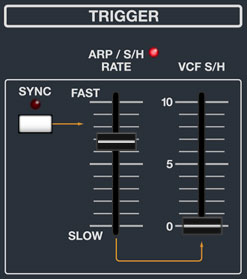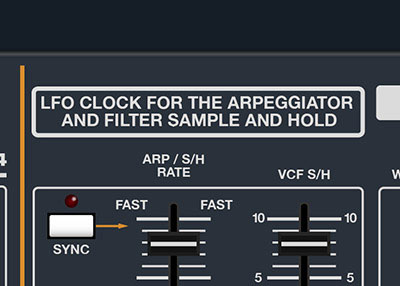
Obviously Trigger isn't a common synthesizer section; a more appropriate (and admittedly less catchy) name might be "LFO Clock For The Arpeggiator and Filter Sample and Hold," but as you can see below, it didn't look so hot on the front panel... so Trigger it is.

Unlike most vintage synths, this means the arpeggio rate is independent of the LFO rate. It's particularly useful when creating bizarro modular-like patches where the arpeggio is running super slow while the LFO is running at crazy-fast audio rates and modulating oscillator pitch, filter cutoff, VCA amplitude, or some combination thereof.
Sync- When the Sync button is enabled, Trigger speed will lock to host tempo when using Mercury-4 within DAW software, or to the current tempo in the top menu bar when using the standalone version.
Arp / S/H Rate- The Arp / S/H Rate slider sets the clock rate of the arpeggiator and filter sample and hold, from 0.25 to 20 Hz (with Sync switch off) or from 8 beats up to 1/64th note triplets (Sync switch on).
VCF S/H- The original instrument includes a "hidden" sample and hold mod source for filter cutoff. We say hidden because the original front panel is cryptically labeled VCF Mod, so we changed it to something more descriptive. For those unfamiliar with what a sample and hold does, it grabs voltages from a sample source (in this case, the noise generator, for random voltages) and holds them at durations specified by a clock source. The VCF S/H slider defines how much of this mod gets applied to the filter cutoff frequency.
To hear its effect, set the filter frequency to its lower region, and turn up VCF S/H slider; try turning up the Res slider as well and you'll hear the sound that spawned a thousand sci-fi robots.